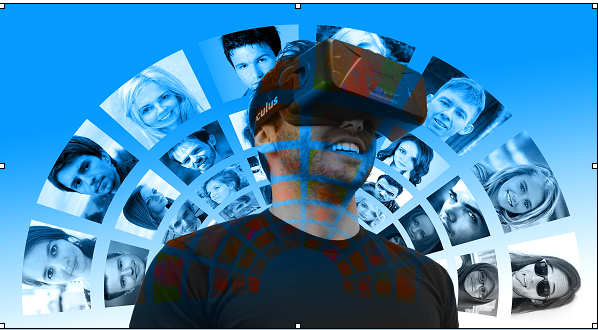With each passing day, technology is dissolving the boundaries between the physical and digital worlds. From the introduction of personal computers to the rise of smartphones, the way we interact with digital technology has changed dramatically. But the next wave of transformation is already upon us, and it’s called the metaverse. The metaverse is the convergence of augmented reality (AR), virtual reality (VR), and the internet into a seamless, interconnected digital world. This blog will explore the future of digital worlds by examining the intersection of AR, VR, and the metaverse.
Augmented Reality (AR) – Enhancing the Real World

Movies often depict technologies that represent our aspirations for the future. For example, in “Spider-Man: Far From Home,” Tony Stark gives Peter Parker a pair of augmented reality glasses that use holographic technology to overlay computer-generated images onto the real world. This allows the wearer to access a vast array of information and control various devices with voice commands or hand gestures. AR technology provides a new level of interaction between digital technology and the physical world, enhancing our perception and understanding of reality. Moreover, augmented reality has the potential to provide us with more information about the world around us and could potentially alter human perception of nature.
Definition of Augmented Reality:
Microsoft defines augmented reality as a digital experience that enhances and interacts with the real-world environment using visual elements, sounds, and other sensory stimuli through the use of holographic technology.
Here are three key features that define augmented reality:
- Combination of the digital and physical worlds: AR merges the digital and physical worlds, allowing users to experience virtual objects in a real-world setting.
- Real-time interactions: AR provides real-time interactions with virtual objects, allowing users to manipulate and interact with digital content in real-time.
- 3D identification of virtual and real objects: AR can identify and track real-world objects in 3D space, enabling virtual objects to be anchored to specific physical locations.
Applications of Augmented Reality :
Augmented reality technology has a wide range of applications across various industries.
Here are some examples:
- AccuVein uses AR to help medical professionals locate a patient’s veins more efficiently.
- Social media: Snapchat’s ‘face swap’ filter uses AR technology to superimpose one person’s face onto another’s body in real-time.
- Marketing: The IKEA Place app in retail allows customers to visualize furniture in their homes before making a purchase. Similarly, the L’oreal makeup genius app enables users to try out makeup on their skin without actually applying it.
- Gaming: Popular mobile games like Pokémon Go use AR to place virtual creatures in real-world environments.
- Education :AR technology creates interactive learning experiences that help students better understand complex concepts. For instance, the Merge Cube app enables students to explore the water cycle, view fossils, examine rocks and gemstones.
- Healthcare: AR can be utilized to enhance patient outcomes by providing real-time medical information to healthcare providers. For instance, AccuVein uses AR to help medical professionals locate a patient’s veins more efficiently.
Virtual Reality (VR) – Immersing Yourself in a Digital World

A world where anything is possible, where you can fly, explore new worlds, and even travel through time – all without leaving your living room. Welcome to the world of virtual reality.
Definition of Virtual Reality:
According to Encyclopedia Britannica, virtual reality (VR) is the use of computer modeling and simulation that allows a person to interact with an artificial three-dimensional (3-D) visual or other sensory environment, creating an entirely new digital environment that immerses the user in a computer-generated world. According to William R. Sherman and Alan B. Craig in their book “Understanding Virtual Reality: Interface, Application, and Design,” virtual reality has four essential components:
- Virtual world: The virtual environment is computer-generated and can range from a simple 3-D model to a complex digital world.
- Immersion: VR technology immerses users in the digital environment, creating a sense of presence that allows them to interact with virtual objects as if they were real.
- Sensory feedback: VR technology provides sensory feedback to users through visual, auditory, and haptic (touch) sensations, enhancing the sense of immersion.
- Interactivity: VR technology allows users to interact with virtual objects, modifying and manipulating them in real-time.
Applications of Virtual Reality :
Virtual reality (VR) technology is no longer a futuristic concept but a reality in many fields. From entertainment to education, VR has become an increasingly popular tool for immersive experiences. Here are some of the top applications of virtual reality:
- Healthcare: VR technology is used to help treat anxiety and phobias, simulate surgeries for medical students, and even provide pain management for patients during procedures.
- Education: VR is used in education to provide immersive learning experiences in fields such as science, history, and geography.
- Entertainment: VR has transformed the entertainment industry, providing users with interactive experiences in video games, movies, and live events.
- Training and Simulation: VR is used for training purposes in industries such as aviation, military, and emergency services, providing realistic simulations for trainees.
- Sports: VR technology is used to provide athletes with a unique perspective of their performance, enabling them to analyze and improve their skills.
- Architecture and Design: VR technology is used to create 3D models of buildings and structures, allowing architects and designers to visualize and modify designs before construction.
The Metaverse – A Seamless Digital World
The future is here, and it’s called the Metaverse – a revolutionary digital realm that will redefine our reality and revolutionize the way we experience the world around us.
The term ‘metaverse’ was coined by Neal Stephenson in his 1992 sci-fi novel Snow Crash, but no one knew that this term would become the aspiration for the world and the vision of the future for all tech enthusiasts.
Major companies like Meta, Epic Games, and Microsoft. are investing in the development of the metaverse, here we have concluded their own metaverse visions:
| Meta | ● Facebook has rebranded to Meta, with a focus on the metaverse. ● Meta’s focus is on developing fundamental technologies for the metaverse. ● Users won’t need a Facebook account to use other services in the metaverse. ● Meta has sold millions of VR headsets for navigating the metaverse. ● Meta has launched Horizon Worlds, a VR space that users can navigate as an avatar, along with tools for developers to create additional virtual worlds. ● Meta’s investment in the metaverse is considered a gamble by investors due to revenue declines and layoffs in an uncertain economy |
| Microsoft | ● Microsoft Teams is competing with Zoom as an online meetings platform and is adding the metaverse to allow for collaborative, holographic experiences. ● The platform includes AI-powered tools, such as avatars, session management, spatial rendering, and holoportation for real-time 3D models of people. ● A private preview feature was launched at the October 2022 Ignite conference, allowing users to create and use avatars instead of live video during Teams meetings. ● Microsoft is working with Accenture to create Mesh-enabled immersive spaces for onboarding new employees, including One Accenture Park – a virtual space with a conference room, boardroom, and monorails for traveling between exhibits. ● One Accenture Park is part of the company’s onboarding process for over 100,000 new hires annually. |
| Epic Games | ● Epic Games plans to enter the metaverse after securing $1 billion in funding in 2021, including $200 million from Sony Group Corp. ● Epic Games is the maker of Fortnite and the Unreal Engine software for game developers. ● The company aims to provide a communal space for users to interact with each other and brands. ● Epic Games’ vision of the metaverse differs from Meta’s as it seeks to avoid a news feed filled with ads. |
The metaverse is expected to rely heavily on virtual reality (VR) and augmented reality (AR) technologies. VR offers a simulated 3D environment that replicates reality and is typically accessed through a headset, while AR overlays digital content onto the real world through a lens. However, it’s unclear whether these technologies will be the primary interfaces for the metaverse, as these are seen as pre-metaverse precursors.
Since the metaverse is still evolving and its underlying tools comprise various technologies, experts are uncertain about the specific technologies that will drive its development. Instead of defining specific technologies, they have categorized them using “tech themes.” For instance, Gartner categorized metaverse technologies as spatial computing, digital humans, shared experiences, gaming, and tokenized assets. Meanwhile, Forrester Research called them “enablers of 3D development environments,” requiring skilled professionals in 3D modeling and IoT for developing digital twins.
Esther Shein’s expert sources predict that seven technologies will significantly impact metaverse development in the next decade. These are artificial intelligence, internet of things, extended reality, brain-computer interfaces, 3D modeling and reconstruction, spatial and edge computing, and blockchain. Despite the uncertainty surrounding the specific technologies driving the metaverse’s development, experts predict that several technologies will significantly impact its growth in the coming decade.
Conclusion :
In conclusion, the convergence of augmented reality, virtual reality, and the internet has paved the way for the metaverse – a seamless digital world that will revolutionize the way we experience and interact with technology. Augmented reality enhances our perception of the real world, while virtual reality immerses us in a digital environment. The metaverse will merge the two, creating a new reality where we can interact with virtual objects as if they were real. Therefore, in the future, digital worlds are likely to become even more immersive, interconnected, and integrated into our daily lives, offering endless possibilities for entertainment, education, communication, and beyond.

